Questions 8 910 In a hypothetical study of a major North Ame
Questions 8, 9,&10
In a hypothetical study of a major North American automobile manufacturer, employees provided opinions on a scale of 0 to 100 as follows:
ATTEND: Employee attendance/participation. The percentage of workdays (excluding paid vacation) that the employee was not absent in the 12months prior to the study.
BOARD: The employee\'s support for policies supported by the corporation\'s board of directors in the 12 months prior to the study.
DIV: The employee\'s support for positions take by the director of the employee\'s own division in the 12 months prior to the study.
SECUR: The employee\'s feelings of security in keeping his or her present job during the coming year.
PARTIC: The employee\'s support for a participatory decisions-making approach similar to the one used by several Japanese competitors.
OPPOR: The employee\'s self-assessment of opportunity for promotion/advancement in the coming year.
UNION: The employee\'s support for expanded trade union activities in the firm.
SALARY: The employee\'s perception of the likelihood of receiving a major pay raise in his or her current job sometime in the next year.
MGTPOP: All 89 of the highest-level managers in the corporation (top and upper-middle levels).
EMPLOY: A randomly selected sample of 50 employees working under the top and middle managers at the firm.
Question 8
Here are the mean scores for the management population and the employee sample:
Variable
MGTPOP
EMPLOY
ATTEND
92.35
92.92
BOARD
57.11
37.38
DIV
74.94
78.22
SECUR
56.16
50.70
PARTIC
48.59
60.20
OPPOR
42.52
36.64
UNION
42.47
71.30
SALARY
53.87
53.82
Do managers and employees differ in terms of attendance?
Which group supports the board of directors\' decisions more?
Which group has the greater sense of both security and opportunity?
Assuming that support for union activity expansion is a measure of employee discontent, is your conclusion in comparing the means for UNION consistent with your conclusion in part C?
Question 9
Here are the mean scores for the management population broken into Top and Upper-Middle management:
Variable
Top Mgmt
Upper-Middle Mgmt
ATTEND
93.07
91.80
BOARD
69.79
47.22
DIV
70.20
78.64
SECUR
77.15
39.80
PARTIC
18.46
72.10
OPPOR
75.92
16.48
UNION
32.74
85.66
SALARY
76.66
36.10
A. Compare the two groups of managers in terms of:
Attendance
Support for the board of directors
Support for division directors\' decisions
B. Do you sense a certain level of discontent in upper-middle management?
Question 10
Two groups are compared in the following sets of data.
Upper-Middle Management
Variable
N
Mean
S.D.
ATTEND
50
91.80
12.83
BOARD
50
47.22
10.91
DIV
50
78.64
15.16
SECUR
50
39.80
31.02
PARTIC
50
72.10
22.01
OPPOR
50
16.48
18.20
UNION
50
85.66
10.81
SALARY
50
36.10
11.11
White-Collar Employees
Variable
N
Mean
S.D.
ATTEND
29
93.31
5.11
BOARD
29
23.89
6.97
DIV
29
84.20
9.43
SECUR
29
31.31
26.79
PARTIC
29
81.89
17.89
OPPOR
29
13.17
16.73
UNION
29
92.44
10.96
SALARY
29
35.00
14.77
Questions 8, 9,&10
In a hypothetical study of a major North American automobile manufacturer, employees provided opinions on a scale of 0 to 100 as follows:
ATTEND: Employee attendance/participation. The percentage of workdays (excluding paid vacation) that the employee was not absent in the 12months prior to the study.
BOARD: The employee\'s support for policies supported by the corporation\'s board of directors in the 12 months prior to the study.
DIV: The employee\'s support for positions take by the director of the employee\'s own division in the 12 months prior to the study.
SECUR: The employee\'s feelings of security in keeping his or her present job during the coming year.
PARTIC: The employee\'s support for a participatory decisions-making approach similar to the one used by several Japanese competitors.
OPPOR: The employee\'s self-assessment of opportunity for promotion/advancement in the coming year.
UNION: The employee\'s support for expanded trade union activities in the firm.
SALARY: The employee\'s perception of the likelihood of receiving a major pay raise in his or her current job sometime in the next year.
MGTPOP: All 89 of the highest-level managers in the corporation (top and upper-middle levels).
EMPLOY: A randomly selected sample of 50 employees working under the top and middle managers at the firm.
Question 8
Here are the mean scores for the management population and the employee sample:
Variable
MGTPOP
EMPLOY
ATTEND
92.35
92.92
BOARD
57.11
37.38
DIV
74.94
78.22
SECUR
56.16
50.70
PARTIC
48.59
60.20
OPPOR
42.52
36.64
UNION
42.47
71.30
SALARY
53.87
53.82
a. Do managers and employees differ in terms of attendance?
b. Which group supports the board of directors\' decisions more?
c. Which group has the greater sense of both security and opportunity?
d. Assuming that support for union activity expansion is a measure of employee discontent, is your conclusion in comparing the means for UNION consistent with your conclusion in part C?
Question 9
Here are the mean scores for the management population broken into Top and Upper-Middle management:
Variable
Top Mgmt
Upper-Middle Mgmt
ATTEND
93.07
91.80
BOARD
69.79
47.22
DIV
70.20
78.64
SECUR
77.15
39.80
PARTIC
18.46
72.10
OPPOR
75.92
16.48
UNION
32.74
85.66
SALARY
76.66
36.10
A. Compare the two groups of managers in terms of:
- Attendance
- Support for the board of directors
- Support for division directors\' decisions
B. Do you sense a certain level of discontent in upper-middle management?
Question 10
Two groups are compared in the following sets of data.
Upper-Middle Management
Variable
N
Mean
S.D.
ATTEND
50
91.80
12.83
BOARD
50
47.22
10.91
DIV
50
78.64
15.16
SECUR
50
39.80
31.02
PARTIC
50
72.10
22.01
OPPOR
50
16.48
18.20
UNION
50
85.66
10.81
SALARY
50
36.10
11.11
White-Collar Employees
Variable
N
Mean
S.D.
ATTEND
29
93.31
5.11
BOARD
29
23.89
6.97
DIV
29
84.20
9.43
SECUR
29
31.31
26.79
PARTIC
29
81.89
17.89
OPPOR
29
13.17
16.73
UNION
29
92.44
10.96
SALARY
29
35.00
14.77
Compare the means and the standard deviations for each variable. Discuss your conclusions?
| Variable | MGTPOP | EMPLOY |
| ATTEND | 92.35 | 92.92 |
| BOARD | 57.11 | 37.38 |
| DIV | 74.94 | 78.22 |
| SECUR | 56.16 | 50.70 |
| PARTIC | 48.59 | 60.20 |
| OPPOR | 42.52 | 36.64 |
| UNION | 42.47 | 71.30 |
| SALARY | 53.87 | 53.82 |
Solution
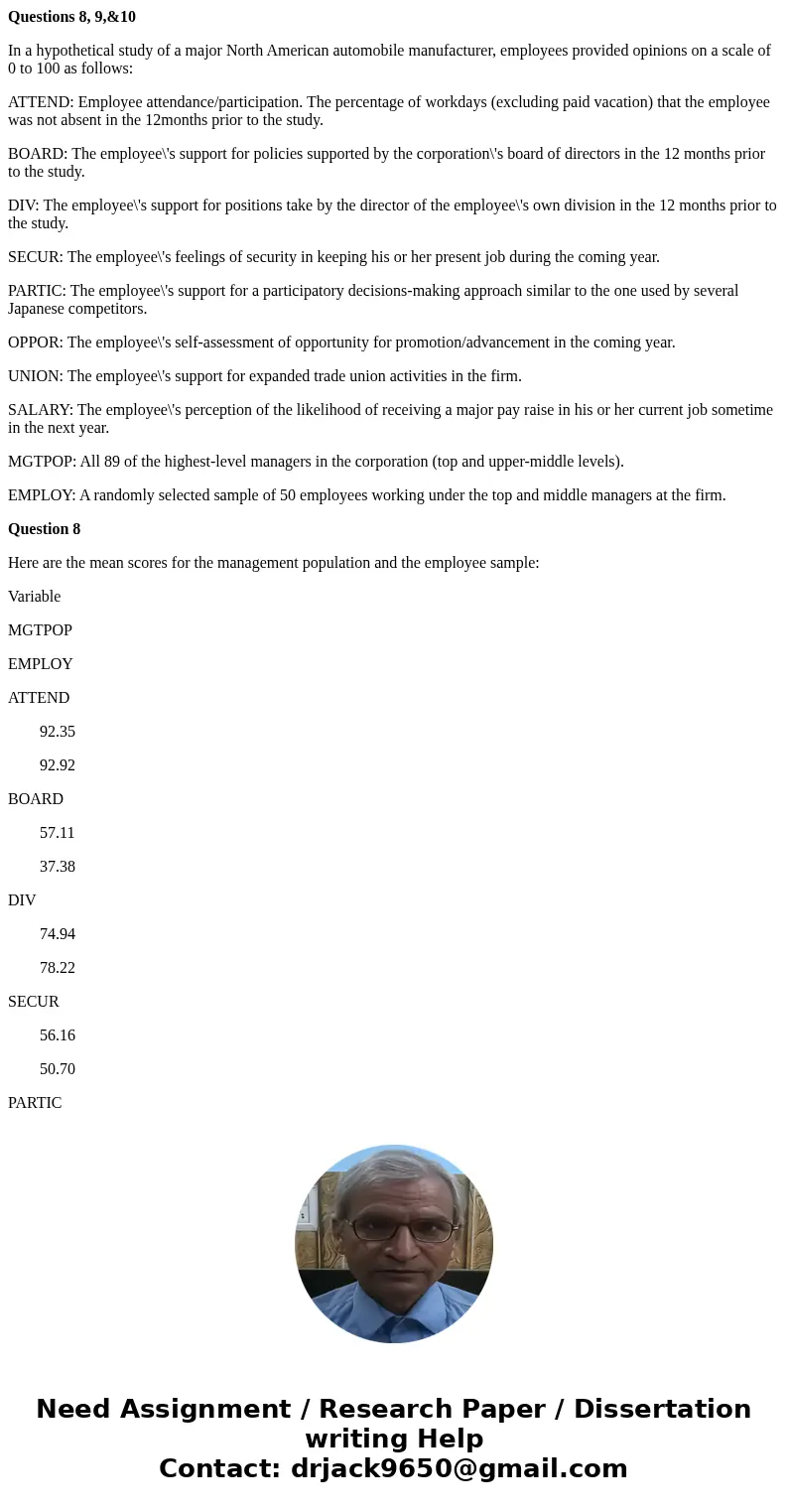
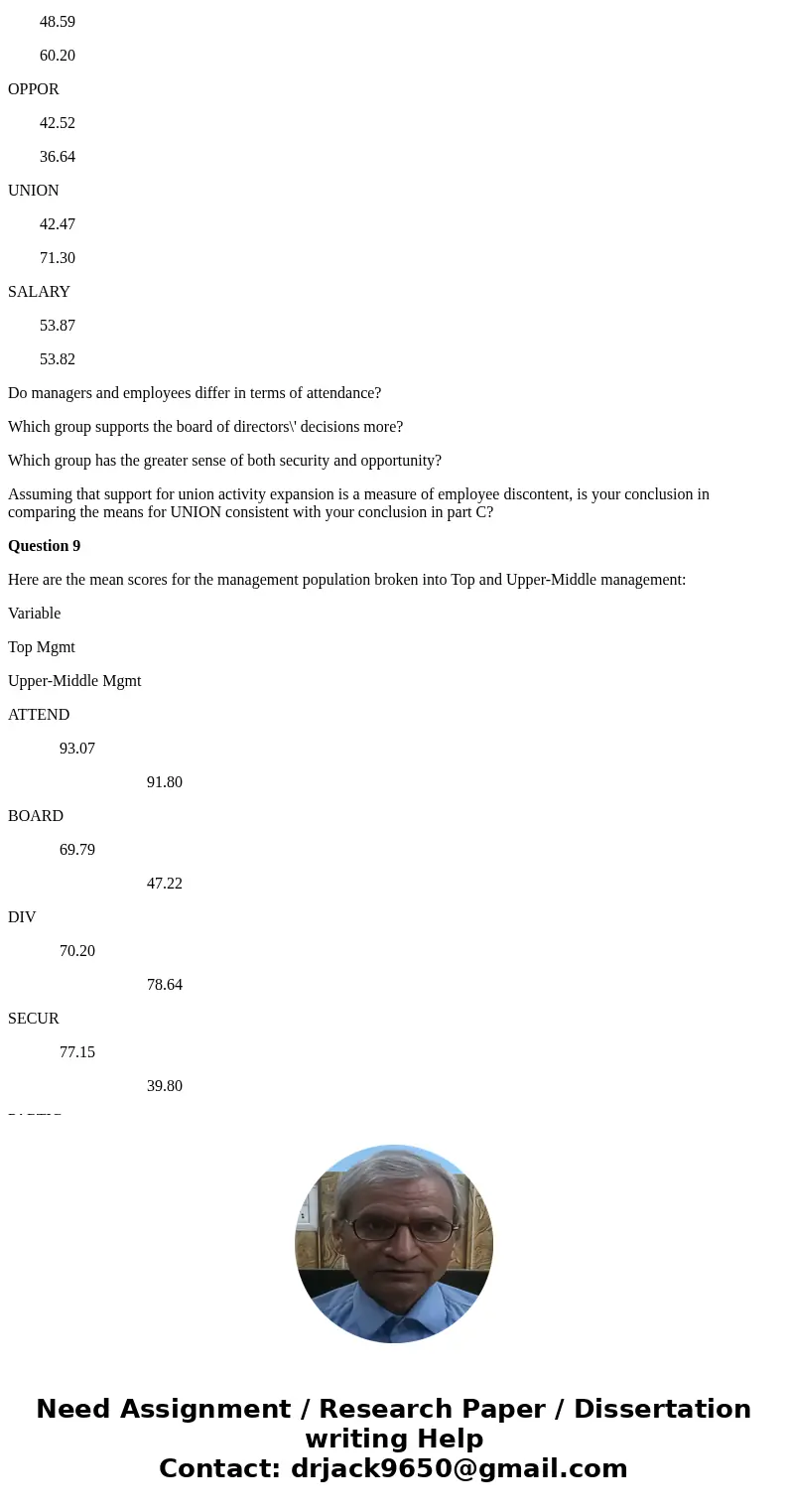
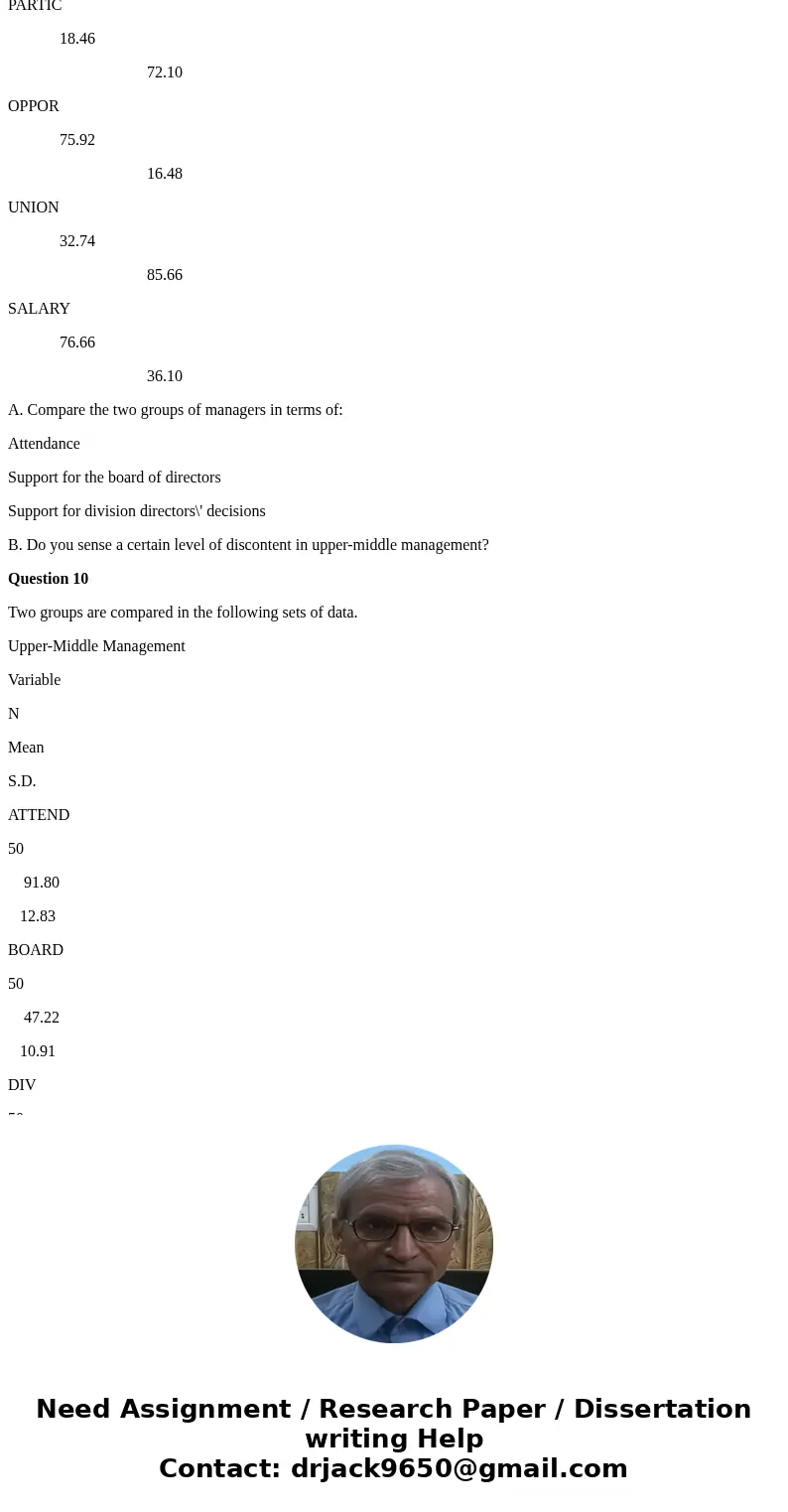
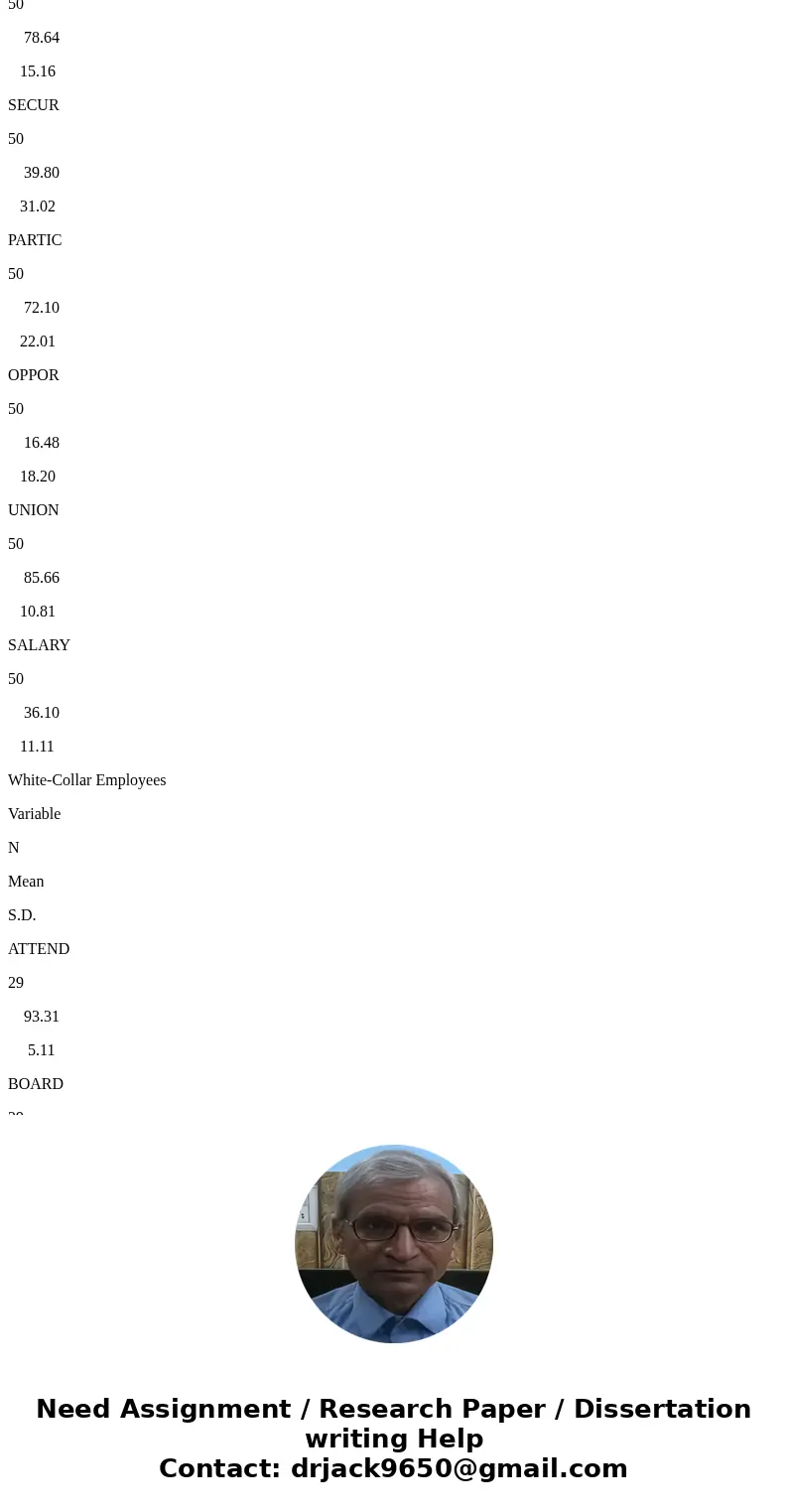
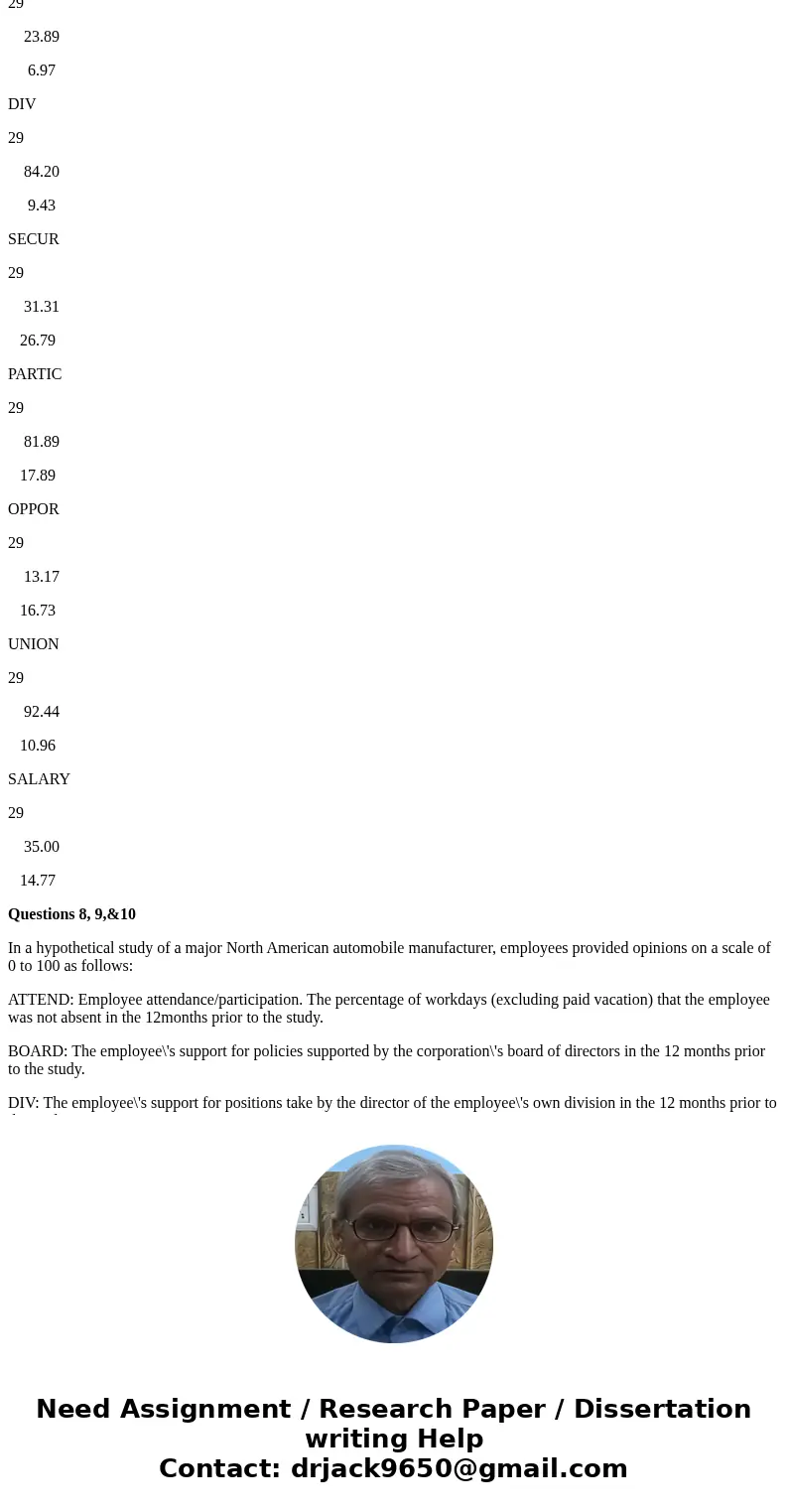
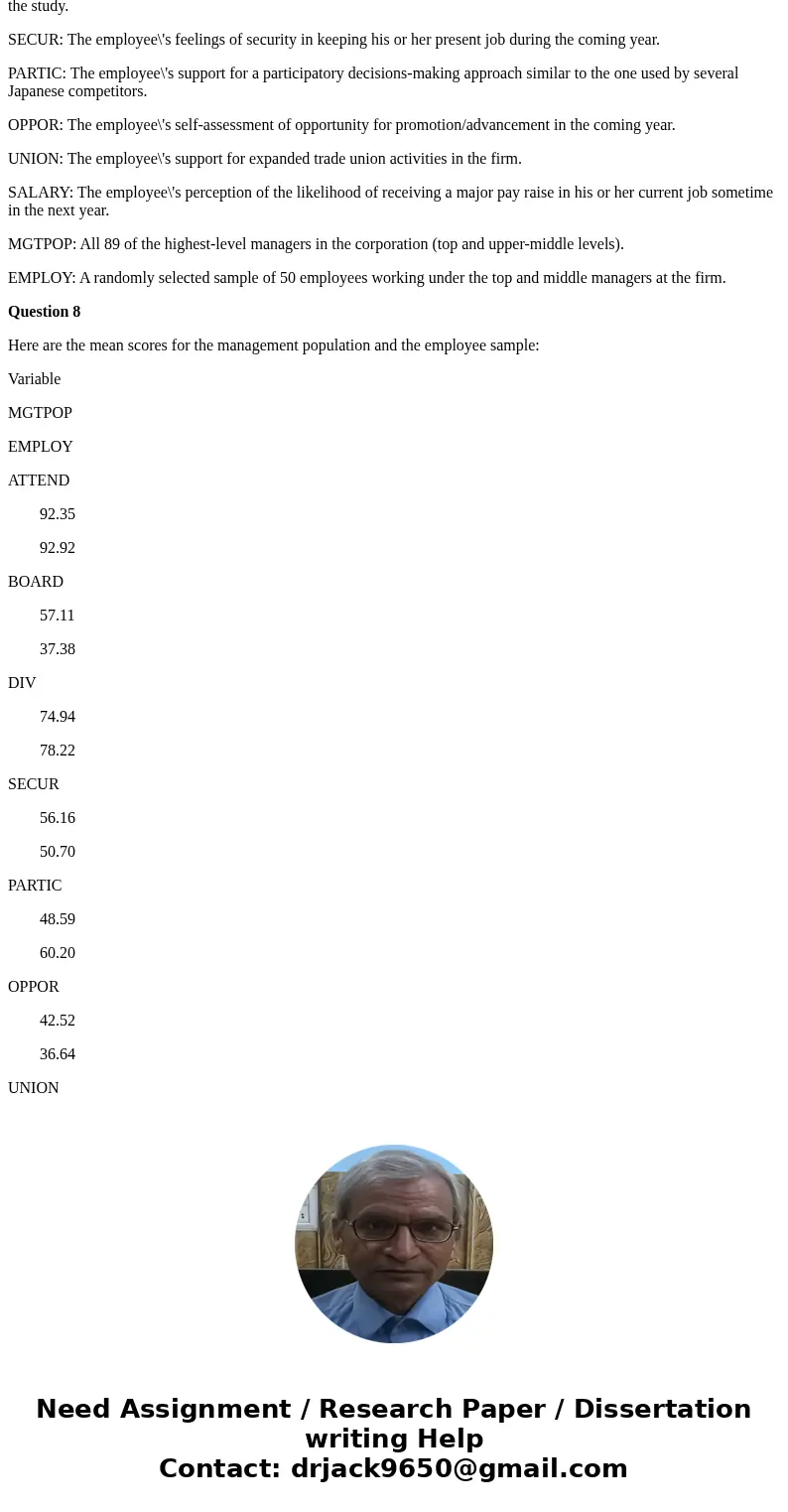
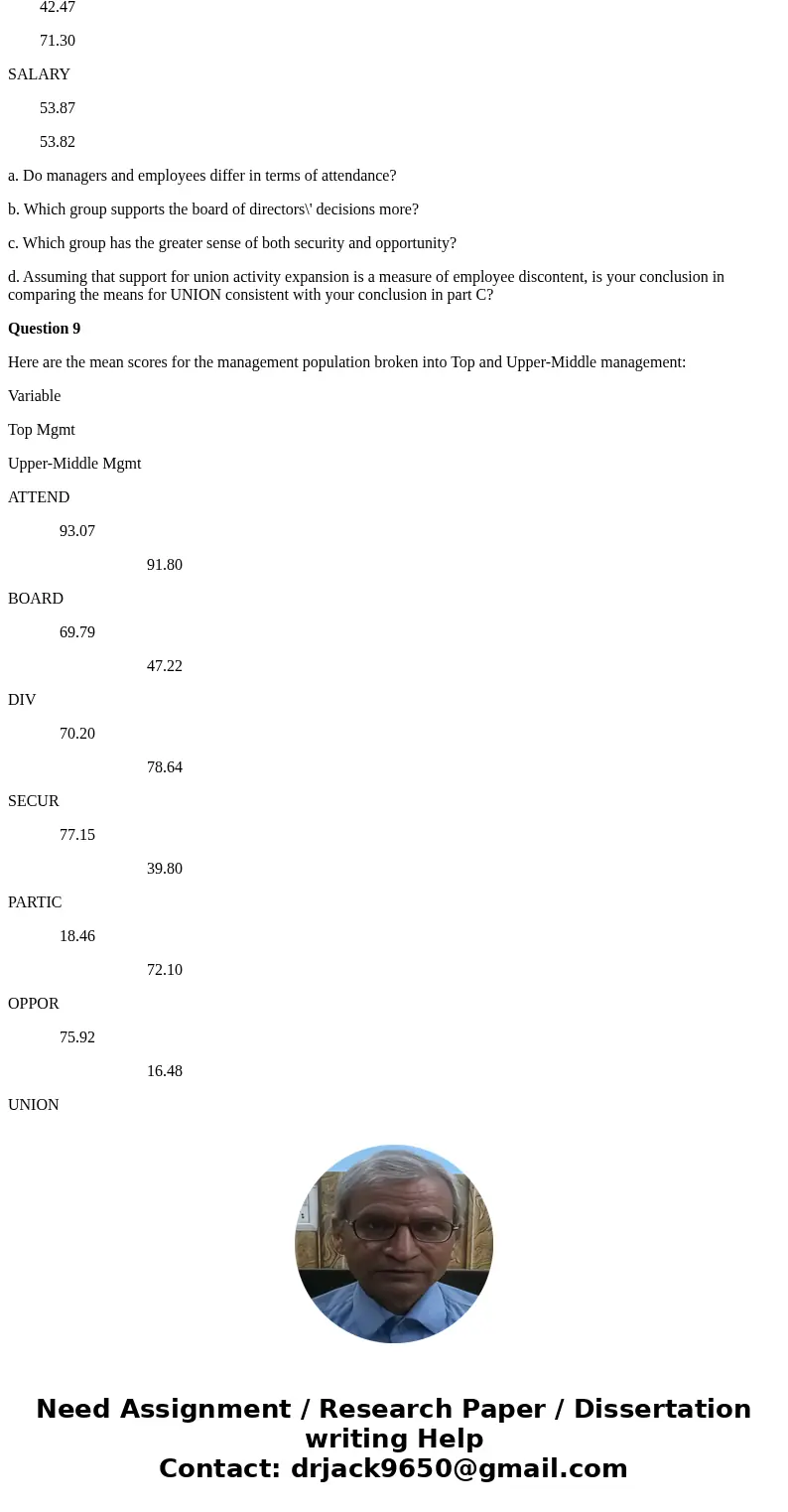
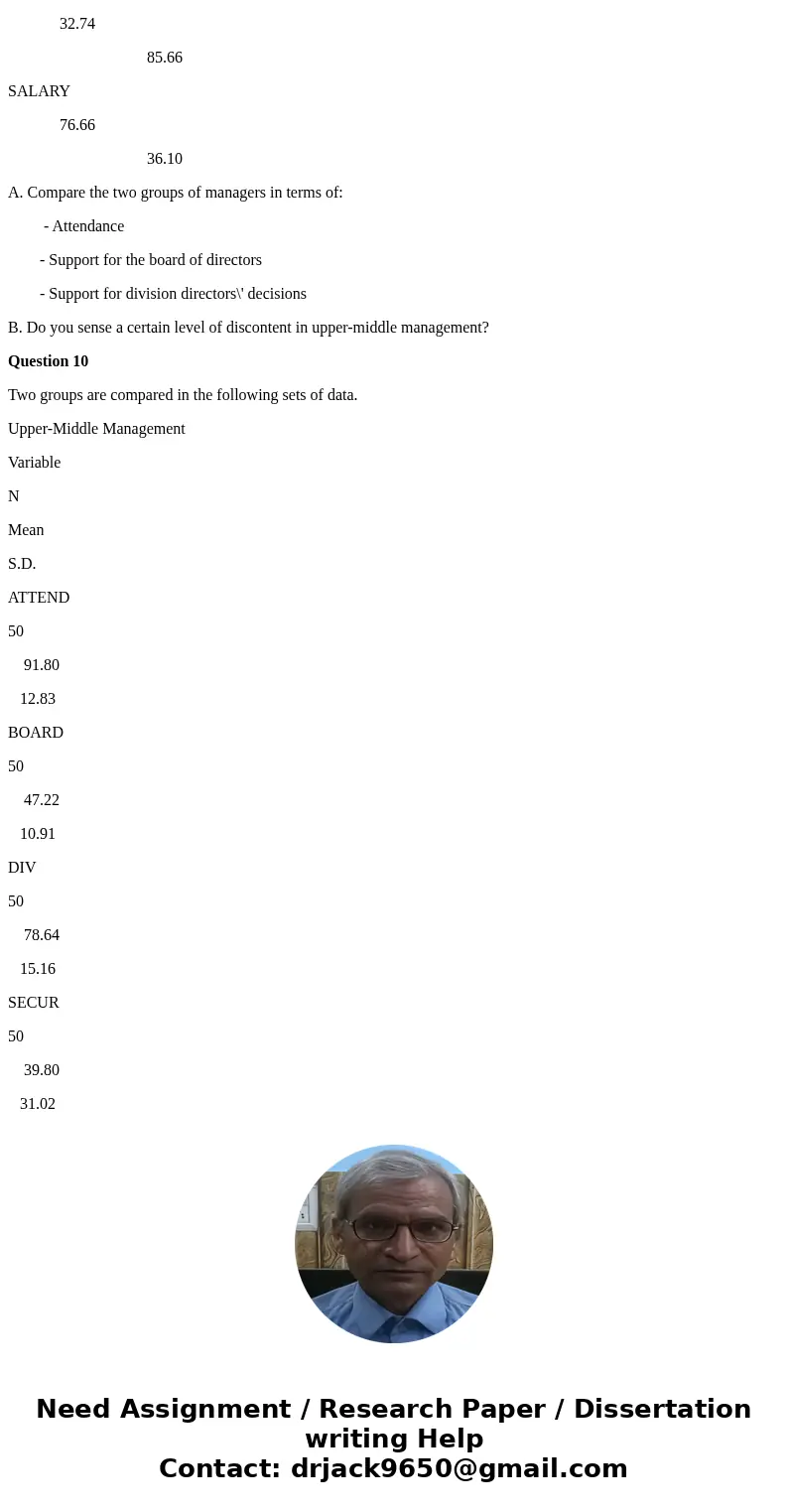
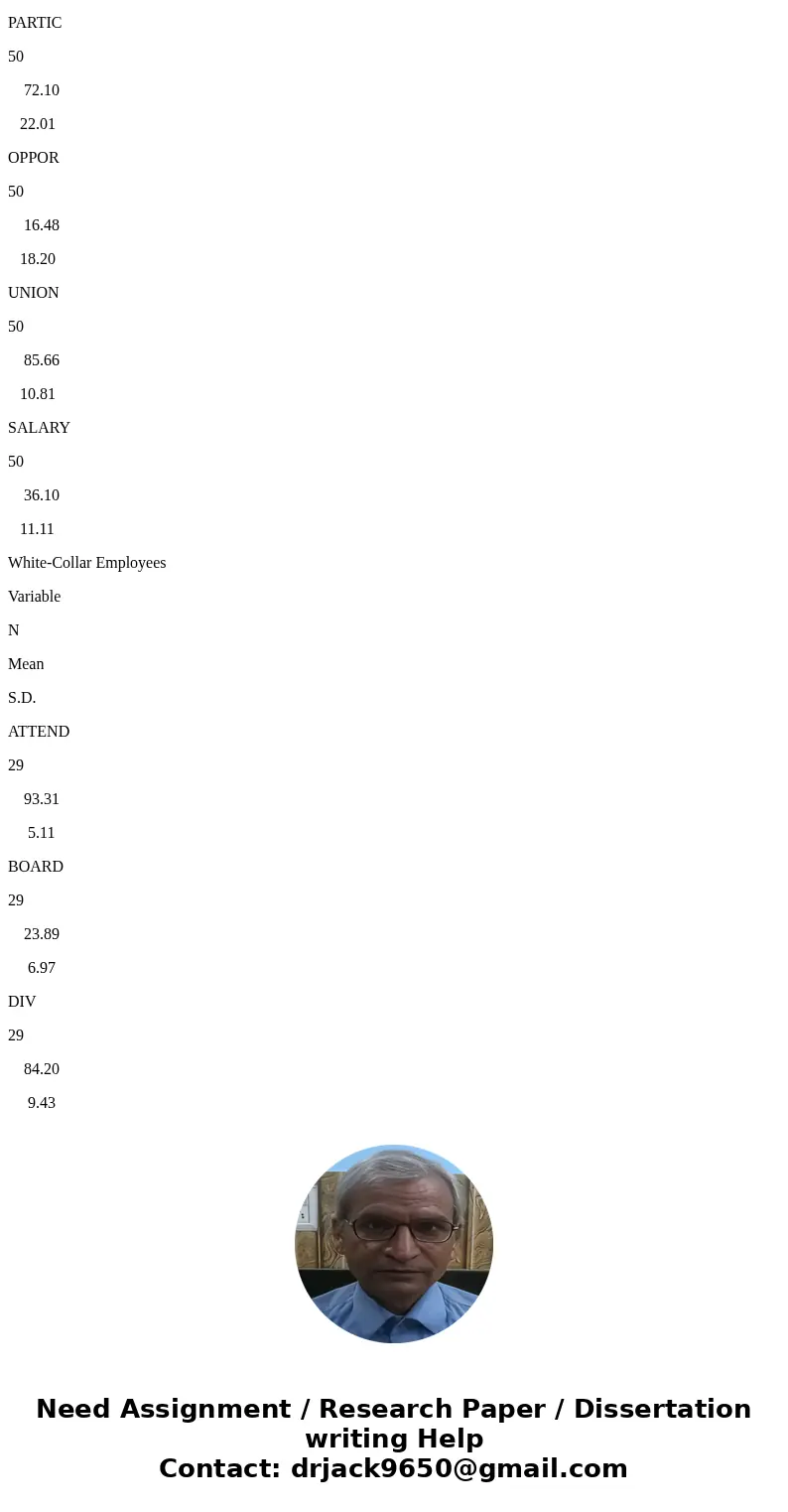
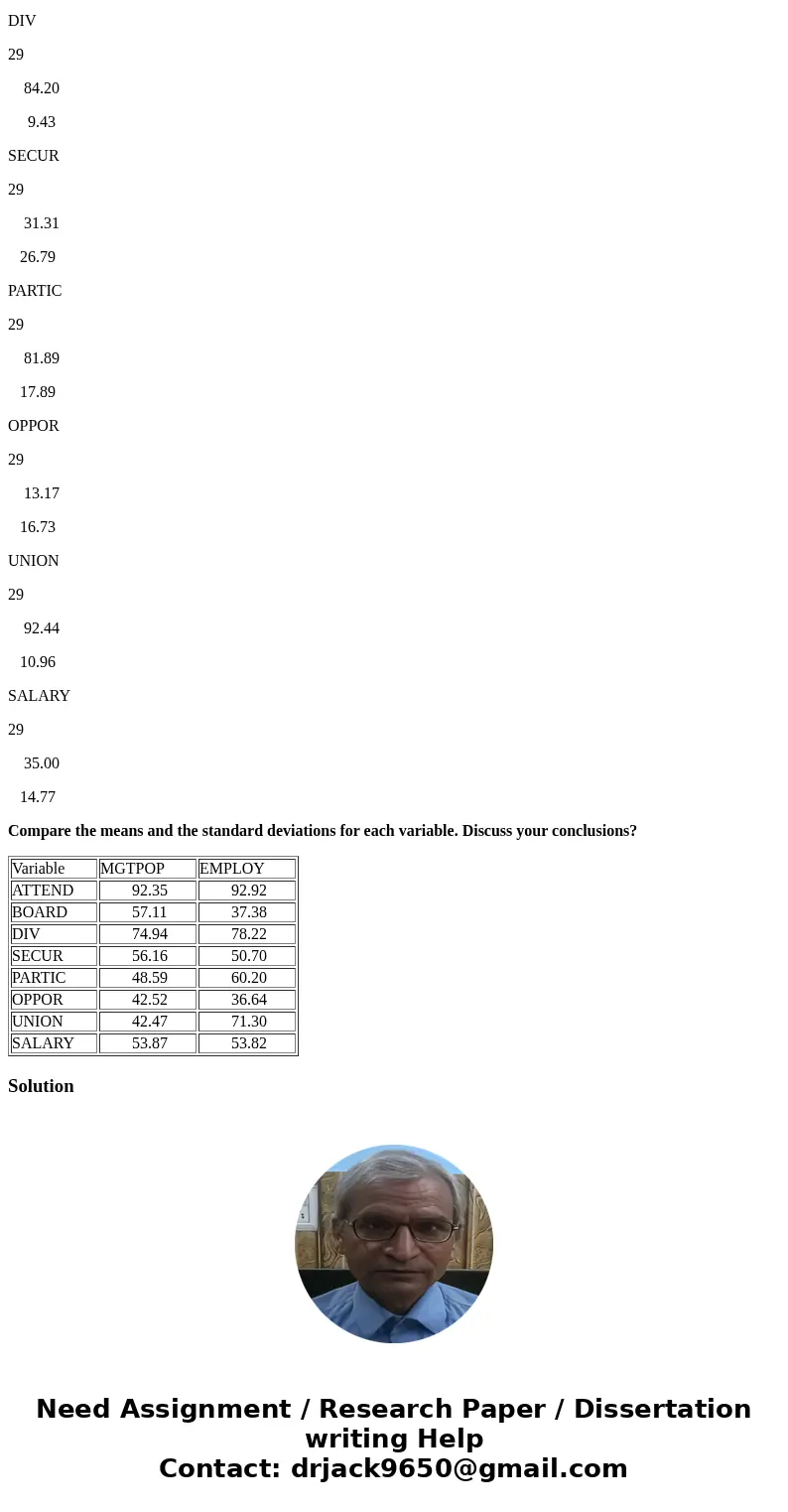
 Homework Sourse
Homework Sourse